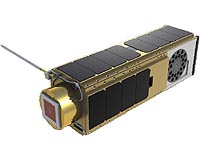 |
Paris (AFP) Nov 24, 2010 Scientists unveiled on Wednesday a gossamer, ghostly creature discovered in the deepest reaches of the ocean between Indonesia and the Philippines. The squidworm, up to 9.4 centimetres (3.7 inches) in length, is far more elegant than its name would suggest. Swimming upright, it navigates by moving two body-length rows of thin, paddle-shaped protrusions that cascade like dominoes. Ten tentacles as long or longer than its body stick out of its head, along with six pairs of curved nuchal organs that allow the squidworm to taste and smell underwater. Using a remotely-operated submersible, a trio of marine biologists led by Karen Osborn of the Scripps Institution of Oceanography in California found the previously unknown animals in the Celebes Sea at a depth of 2.8 kilometres (1.7 miles). "I was really excited," Osborn said of her first glimpse. "It was so tantalising because the animal was so different from anything previously described, with the fantastic headgear." Squidworms live about 100 to 200 metres above the ocean floor, a layer rich in undiscovered fauna and flora, scientists say. "I would estimate that when exploring the deep water column, more than half the animals we see are undescribed or new to science," Osborn said in an email. Up to now, this region has been largely inaccessible because tools for collecting samples either scraped along the ocean floor, or mangled specimens so badly that they were useless or unrecognizable once brought to the surface. The squidworm, Teuthidodrilus samae, does not appear to be a predator, feeding instead on bits of so-called "marine snow," a mix of sinking microscopic plants and animals, faecal material and cast-off mucus. "Not the most appealing sounding food, but the large aggregates are rich in nutrients to feed on," Osborn said. The Celebes Sea, a deep pocket basin isolated from surrounding deep water, is part of the Coral Triangle, a conservation hot spot due to its diverse lifeforms and unique geological history. The squidworm is so different from known animals that it required the creation of a new genus, the level above species in the taxonomical ladder for classifying animals and plants. The study was published in Biology Letters, a journal of the British Royal Society.
Share This Article With Planet Earth
Related Links Life Beyond Earth Lands Beyond Beyond - extra solar planets - news and science
 NASA Satellite Reaches Orbit, Begins Astrobiology Experiments
NASA Satellite Reaches Orbit, Begins Astrobiology ExperimentsMoffett Field CA (SPX) Nov 24, 2010 The Organism/Organic Exposure to Orbital Stresses, or O/OREOS, nanosatellite managed by NASA's Ames Research Center, successfully launched at 5:25 p.m. PST on Friday, Nov. 19, 2010, from Alaska Aerospace Corporations Kodiak Launch Complex on Kodiak Island, Alaska. O/OREOS rode into orbit aboard a four-stage Air Force Minotaur IV rocket. Also aboard were the Air Force Research Laboratorys S ... read more |
|
| The content herein, unless otherwise known to be public domain, are Copyright 1995-2010 - SpaceDaily. AFP and UPI Wire Stories are copyright Agence France-Presse and United Press International. ESA Portal Reports are copyright European Space Agency. All NASA sourced material is public domain. Additional copyrights may apply in whole or part to other bona fide parties. Advertising does not imply endorsement,agreement or approval of any opinions, statements or information provided by SpaceDaily on any Web page published or hosted by SpaceDaily. Privacy Statement |